
Wine Culture and Information since 2002 - Volume 22
 Wine Culture and Information since 2002 - Volume 22 |
|
Issue 179, December 2018 |
Contents |
|
|
The Challenge of Nothing in the Name of Wine |
|
Wine, what a mixed blessing, subject of endless challenges and debates, so frequently used for the self-celebration of those who are always convinced to be competent in saying a banality in the name of Bacchus and, with such a vanity, even authoritative experts. In particular, the debates about which territory or country is the best in making wine, is something which makes me smile, especially when they are clearly based on suppositions, so to speak, of chauvinist principles. What is even more surprising is that those who are used in supporting these crusades for the defense of home affairs usually never have solid arguments to support their ideas. Even worse, the only wines these irreducible defenders have ever drank (saying “tasted”, in this case, seems decidedly excessive to me) are those of the territory for which they proclaim themselves as proud vanguards and defenders. In order to give some examples – not to be meant in any way to belittle or magnify any of the territories or wines mentioned – Prosecco is better than Champagne, Franciacorta is better than Trento, Italian wine is better than the French one. Frivolities of this kind are so frequently heard, nevertheless, inappropriately, without having sufficient concrete elements to support one or the other hypothesis. Putting on the same level of comparison two very different wines – by territory, production technique and grapes – not only is something totally devoid of even the most basic and common sense, but denotes an endless ignorance of those who support such a silly hypothesis. Moreover, supporting a wine – a food, a culture or anything else – is better than another one only because it belongs to a certain territory, without giving further reasons, is a ridiculous act of pathetic arrogance, not to mention, of cultural poverty. Trying to not offend anyone, in particular producers of specific wine-growing areas, as an example I will use a broad and generic case, aware of the fact – probably – someone will however feel offended by this. Let's take the two countries that, since memorable times, are compared in the most disparate wine terms: Italy and France. There have always been too many who have been struggling with the most varied disputes between these two countries: which one makes more wine, which one is the best, which one have the best grapes and so on. Is Italian wine better than French wine? Is the French one better than the Italian one? It is like asking which of two pictures is the most beautiful, without providing any other term for comparison. Italian wine is certainly excellent and very good. The same can be said – undoubtedly – for French wine. However, in case we remain on generic and decidedly vague comparison terms, therefore evidently inconsistent. Better according to what principle? Better taste? Worse nose? We inevitably get into an evidently subjective matter, therefore strongly debatable in objective terms, not to mention technical, viticultural and enological ones. How can one, in any case, argue the wines of a territory are better than those made in another one only because they come from or were produced in that territory? At least, it presupposes the really vague principle all the producers of that territory are irreducibly, firmly and unquestionably committed to the highest quality. By evaluating the production of a territory – in general and broad sense – there are far too many proofs denying and contradicting this supposition in an obvious and evident way. In every territory there certainly are producers capable of making wine of the highest quality, likewise there are those, in the same territory, who clearly make wines that are decidedly less significant, even ordinary. Is Italian wine better than French? It depends. Italian wine – and the same can be said for the French ones – is of very high quality and extraordinarily good. However, not all Italian wine – or that of any other country or territory, including France – belongs to this definition and this is something evidently obvious to me. Indeed, I find it much more concrete to compare different producers with the aim of determining the best, however a territory – in its entirety – in my opinion is a totally useless and debatable task. I have a huge passion, just to give another example, for Marsala, the great Sicilian fortified wine, however I do not certainly think it is intelligent to say all Marsala is extraordinary just because it belongs to this denomination. There are Marsala wines made by certain producers having an undeniably amazing quality, while others are obviously far away – at least in my opinion – from this definition. It must also be said that, thanks to the technological and enological progress of the last decades, including the general availability of these notions, everyone can virtually have access to them, the worldwide level of wine quality has evidently increased. Countries that, until a few decades ago, were considered distant from any wine making capacity, they today prove they know how to make wines with an interesting value. Therefore, it is today evident it is particularly frivolous debating on which wine territory is actually the best in a generic or absolute sense. To put it simple, the best does not exist. There are beautiful and good things everywhere in the world, as well as ugly and bad ones. This also undoubtedly applies to wine. If you were wondering whether I prefer French wines to Italian ones, I will tell you that and without hesitation. I love Italian wine and I also love French wine. Not to mention, I love the wine from any other country. As long as it is good, of course. Antonello Biancalana
|
||||
Contrasts of Bombino Bianco and Petite ArvineOne of the white berried varieties of central-southern Italy compared to the grape coming from the Canton Valais in Switzerland, also appreciated in Aosta Valley |
|
The sensorial evaluation of wines produced with grapes having distant organoleptic characteristics is always an interesting subject of study for the understanding of the respective differences. Of course, this does not mean the comparison between two wines produced with the same grapes is not equally interesting. On the contrary, they allow to understand the expression of the same variety according to a territory – including individual vineyards – as well as the personal interpretation of producers. In any case, these are methods of comparison with different purposes and, last but not the least, with different levels of difficulty. The more the differences are evident and distant, the more the tasting becomes – so to speak – simple, because of the ease with which the respective characteristics can be recognized in contrast to the other ones. In the case of comparison of wines produced in the same territory, same grapes, wine making and viticultural techniques, the difficulty increases significantly. This is not the case for the tasting by contrast of this month, as the wines produced with the two grapes chosen for comparison are characterized by decidedly distant sensorial aspects. The first of them – Bombino Bianco – is undeniably one of the most widespread white grape varieties of central-southern Italy, which has also been able to reach the vineyards of certain areas of the northern side. The second one – Petite Arvine – presumably has its origin in lands much further to the north, specifically, in Switzerland. Petite Arvine obviously did not benefit of the same spreading of Bombino Bianco, but it is certainly successful in Switzerland as well as in some areas of France and, last but not the least, in Aosta Valley, Italy. Two varieties producing wines very different from each other and not only for reasons related to the territory, from sight to taste, the differences between Bombino Bianco and Petite Arvine are easily recognizable to our senses.
|
|
Bombino Bianco is undeniably associated to Apulian viticulture and enology, in particular, to the wines of the territories near Bari and Foggia. Its spreading outside Puglia is considerable, especially in the central-southern regions of Italy. Bombino Bianco is in fact found, besides Puglia, in Molise, Abruzzo, Lazio and Marche. It is also found in Emilia Romagna, where it is called Pagadebit or Straccia Cambiale (literally, “promissory note ripper”), to unequivocally testify the proverbial ability of this grape to ensure abundant and generous harvests. The case of Bombino Bianco in Abruzzo is singular, where this variety is allowed for the production of the Trebbiano d'Abruzzo wine, even alone. Thanks to its characteristics – specifically, moderate production of alcohol and evident acidity – Bombino Bianco is also suited for the production of classic method sparkling wines, particularly in Apulia where, since many years now, there is a valuable and interesting production of wines belonging to this style, of excellent quality and organoleptic complexity. The origins of Bombino Bianco are not completely clear, however they all agree it is a white berried grape of ancient origins and present in Apulia for several centuries now. Some support the idea this variety was introduced from Spain, others believe it comes from the Middle East and imported to Apulia by the Knights Templar returning from the holy land. Even the origin of the name is not completely clear, however the most recurrent hypothesis wants Bombino coming from the image of a child (bambino in Italian) in swaddling with outstretched arms, an association derived from the shape of its cluster. In the land of Apulia, Bombino Bianco is strongly associated to the white wines of Castel del Monte, in the provinces of Barletta-Andria-Trani and Bari,San Severo and Cacc'e Mmitte di Lucera, in the province of Foggia.
|
||||
|
The origin of Petite Arvine has always been disputed between Switzerland, to be precise, the territory of the Canton Valais, and Aosta Valley, where excellent wines are produced from this grape. Of the two territories, the one which can give some proofs of being the original homeland of this interesting variety seems to be Switzerland, although there are no reliable and certain information confirming this hypothesis. Even the genetic research has not been able to understand the exact origin of Petite Arvine, including the supposition this grape is a descendant of the ancient Vitis Helvola mentioned by Pliny the Elder, likewise, it was not possible to link this grape to the ancient varieties of Aosta Valley. Today it is however mainly supported the hypothesis the origin of Petite Arvine is in the territory of Martigny – therefore in the Canton Valais, in Switzerland – and it is a known fact the interest in this variety in Aosta Valley had a substantial start in the 1980s. Petite Arvine, in fact, has benefited a remarkable revival in this Italian region thanks to the Institut Agricole Régional of Aosta Valley, in particular thanks to Joseph Vaudan who has properly revalued it by importing this grape from the nearby Canton Valais. If the origins of Petite Arvine are not clear, it is however absolutely certain this variety is capable of producing wines of extraordinary finesse and enological value, both in Aosta Valley and in the territory of Canton Valais. One of the interesting characteristics of Petite Arvine is the aromatic profile it gives its wines, helping to contribute to the well known finesse typical of this variety. The wines produced with Petite Arvine are not characterized by a mighty structure, however they give the palate an elegance expressed by a pleasing crispness and a certain salty character, making its wines definitely minerals. Moreover, Petite Arvine is also well suited to the production of the so-called late harvest wines, including sweet ones produced with dried grapes, sometimes enriched by the effects of Botrytis Cinerea, also known as noble rot.
|
Before pouring into the glasses the wines of this month's tasting by contrast, let's proceed with their choice. If for Bombino Bianco this task may seem relatively simple – thanks to the vast production of wines from this grape and available in many Italian regions – as for Petite Arvine the choice is decidedly more limited. As already said, Apulia is the main land for Bombino Bianco, therefore the first wine of our tasting by contrast belongs to the copious enological production of this region. In particular, we will choose a Bombino Bianco belonging to the Denominazione d'Origine Controllata (Denomination of Controlled Origin) Castel del Monte and making sure it is produced with this variety alone and vinified in inert containers. As for Petite Arvine, our choice will be in favor of the valuable production of Aosta Valley, also in this case making sure the wine is produced with this variety alone and vinified in inert containers. Both wines belong to the most recent vintage, served in two tasting glasses at a temperature of 10 °C. (50 °F) Let's pour the wines into their respective glasses and start our tasting by contrast. The first wine of which we will examine the appearance is Valle d'Aosta Petite Arvine. By tilting the glass over a white surface – a sheet of paper is enough – let's observe the wine at the base, where the thickness is greater. Petite Arvine shows to our eyes an intense greenish yellow color, sometimes a pale straw yellow color, with a very high transparency: an object placed in contrast between the glass and the white surface is perfectly visible. Let's now observe the wine at the end of the glass, towards the opening, in order to evaluate the nuance: also in this case the greenish yellow hue is evident. Let's now pass to the evaluation of Castel del Monte Bombino Bianco. The color of the Apulian wine is decidedly darker than the one from Aosta Valley, showing a strong intense and brilliant straw yellow hue, also in this case with a very high transparency. The nuance of Bombino Bianco, observed at the end of the glass, confirms the same color. Bombino Bianco and Petite Arvine, besides differing in appearance, have very different olfactory profiles, both in terms of aromas' quality and intensity. Wines produced with Bombino Bianco are often characterized by aromas of medium intensity, in which are mainly perceived white and yellow pulp fruits – among these, apple, pear, plum and citrus fruits – as well as sensations which are classified in the family of flowers. Sometimes its wines express a touch of almond. The olfactory profile of Petite Arvine is very different, decidedly more intense and exuberant. In this variety are recognized aromas recalling both white and yellow pulped fruits, including tropical ones, such as pineapple and passion fruit. Wines made from this grape express aromas of apple, pear, peach, citrus fruits, in particular grapefruit. Even the world of flowers is found in Petite Arvine, with evident perceptions of wisteria, hawthorn, broom and jasmine. An interesting aroma often found in wines produced with Petite Arvine is rhubarb. Let's proceed with our tasting by contrast and by evaluating the olfactory profiles of the two wines and, as opposed to the appearance examination, the first wine we are going to evaluate is Castel del Monte Bombino Bianco. By keeping the glass in vertical position and, without swirling, let's proceed with the first smell in order to appreciate the opening of the Apulian wine. From the glass we perceive aromas of moderate intensity directly recalling apple, pear and a floral note of hawthorn. After having swirled the glass, an operation favoring the development of the other aromas, we proceed with the second smell. The profile of Castel del Monte Bombino Bianco is completed with plum, citrus fruits, broom and almond, sometimes with a hint recalling peach. Let's now pass to Valle d'Aosta Petite Arvine and, by keeping the glass in vertical position and without swirling it, we evaluate its opening. Very different from Bombino Bianco, in this wine you can perceive intense aromas of apple, peach and pineapple followed by wisteria. After having swirled the glass, the profile of Petite Arvine is completed with grapefruit, pear, medlar, jasmine and plum, often followed by rhubarb. After having evaluated the aromas of Bombino Bianco and Petite Arvine, it is finally the time to examine their gustatory profiles, starting – just like the previous phase – from the Apulian wine. Let's take a sip of Castel del Monte Bombino Bianco and evaluate its attack, that is, the primary taste sensations perceived in the mouth. The pleasant crispness of the wine – given by acidity – is clearly perceived with an alcoholic impact of medium intensity, two characteristics making this grape interesting for the production of sparkling wines. The structure of the wine is moderate and in the mouth we perceive the flavors of apple, pear and plum, confirming the good correspondence to the nose. Let's now take a sip of Valle d'Aosta Petite Arvine and evaluate its opening. The main sensations perceived in the mouth are clearly dominated by the pleasant acidity, with a proper effect of alcohol making the wine balanced. In the mouth can be perceived flavors of pineapple, peach, pear and grapefruit, also in this case confirming the good correspondence to the nose. Finally, in Petite Arvine wines, can often be appreciated a pleasant salty sensation making the wine both sapid and mineral. It is now the time to move on to the final phase of our tasting by contrast, that is, to the evaluation of the sensations the two wines leave in the mouth after swallowing, in particular the taste-olfactory persistence. The finish of Castel del Monte Bombino Bianco is of good persistence, leaving in the mouth its pleasant and typical acidity, in which are well recognized the flavors of apple, pear and plum, sometimes followed by a slight bitterish taste reminiscent of almond. Let's now pass to the evaluation of Valle d'Aosta Petite Arvine's finish. The taste-olfactory persistence of this wine is decidedly good, leaving in the mouth a pleasant crispness given by the acidity, in which can be perceived flavors of pineapple, peach and grapefruit, as well as the characteristic salty touch. Let's now put the two glasses side by side and proceed with the last olfactory evaluation, first Bombino Bianco and then Petite Arvine: the differences, after the gustatory examination, are decidedly substantial and distant.
|
||||||||
Wines of the Month |
|
|
|
Score legend Prices are to be considered as indicative. Prices may vary according to the country or the shop where wines are bought |

|
|
Brunello di Montalcino Vecchie Vigne 2013 |
|
| Siro Pacenti (Tuscany, Italy) | |
 Sangiovese Sangiovese | |
| Price: € 85.00 | Score: |
 Brilliant ruby red and nuances of garnet red, moderate transparency. Brilliant ruby red and nuances of garnet red, moderate transparency. Intense, clean, pleasing, refined and elegant, starts with hints of
black cherry, plum and violet followed by aromas of raspberry, blueberry,
cigar box, chocolate, tobacco, pink pepper, cinnamon, mace, licorice,
vanilla and menthol. Intense, clean, pleasing, refined and elegant, starts with hints of
black cherry, plum and violet followed by aromas of raspberry, blueberry,
cigar box, chocolate, tobacco, pink pepper, cinnamon, mace, licorice,
vanilla and menthol.
 Tannic attack and however balanced by alcohol, full body, intense
flavors, pleasing crispness. Tannic attack and however balanced by alcohol, full body, intense
flavors, pleasing crispness.
 Very persistent finish with long flavors of black cherry, plum and
raspberry. Very persistent finish with long flavors of black cherry, plum and
raspberry.
 24 months in barrique. 24 months in barrique. |
|
 Game, Roasted meat, Stewed and braised meat, Hard cheese Game, Roasted meat, Stewed and braised meat, Hard cheese |
|

|
|
Brunello di Montalcino Riserva PS 2012 |
|
| Siro Pacenti (Tuscany, Italy) | |
 Sangiovese Sangiovese | |
| Price: € 150.00 | Score: |
 Brilliant ruby red and nuances of garnet red, little transparency. Brilliant ruby red and nuances of garnet red, little transparency. Intense, clean, pleasing, refined and elegant, starts with hints of
black cherry, plum and raspberry followed by aromas of dried violet,
blueberry, blackberry, dried rose, chocolate, pink pepper, tobacco,
leather, licorice, mace, cigar box, thyme, vanilla, graphite and menthol. Intense, clean, pleasing, refined and elegant, starts with hints of
black cherry, plum and raspberry followed by aromas of dried violet,
blueberry, blackberry, dried rose, chocolate, pink pepper, tobacco,
leather, licorice, mace, cigar box, thyme, vanilla, graphite and menthol.
 Tannic attack and however balanced by alcohol, full body, intense
flavors, pleasing crispness. Tannic attack and however balanced by alcohol, full body, intense
flavors, pleasing crispness.
 Very persistent finish with long flavors of black cherry, plum and
blueberry. Very persistent finish with long flavors of black cherry, plum and
blueberry.
 24 months in barrique. 24 months in barrique. |
|
 Game, Roasted meat, Stewed and braised meat, Hard cheese Game, Roasted meat, Stewed and braised meat, Hard cheese |
|

|
|
Salomone 2015 |
|
| Fattoria di Monticello (Umbria, Italy) | |
 Cabernet Sauvignon Cabernet Sauvignon | |
| Price: € 15.00 | Score: |
 Deep ruby red and nuances of ruby red, little transparency. Deep ruby red and nuances of ruby red, little transparency. Intense, clean, pleasing and refined, starts with hints of black
currant, black cherry and plum followed by aromas of violet, blueberry,
peony, cocoa, tobacco, mace, vanilla and eucalyptus. Intense, clean, pleasing and refined, starts with hints of black
currant, black cherry and plum followed by aromas of violet, blueberry,
peony, cocoa, tobacco, mace, vanilla and eucalyptus.
 Tannic attack and however balanced by alcohol, full body, intense
flavors, agreeable. Tannic attack and however balanced by alcohol, full body, intense
flavors, agreeable.
 Persistent finish with flavors of black currant, black cherry and plum. Persistent finish with flavors of black currant, black cherry and plum. 12 months in barrique. 12 months in barrique. |
|
 Game, Roasted meat, Stewed and braised meat, Hard cheese Game, Roasted meat, Stewed and braised meat, Hard cheese |
|
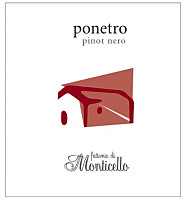
|
|
Ponetro 2016 |
|
| Fattoria di Monticello (Umbria, Italy) | |
 Pinot Nero Pinot Nero | |
| Price: € 14.00 | Score: |
 Brilliant ruby red and nuances of garnet red, moderate transparency. Brilliant ruby red and nuances of garnet red, moderate transparency. Intense, clean, pleasing and refined, starts with hints of cherry, plum
and strawberry followed by aromas of raspberry, cyclamen, blueberry, cocoa,
tobacco, vanilla and menthol. Intense, clean, pleasing and refined, starts with hints of cherry, plum
and strawberry followed by aromas of raspberry, cyclamen, blueberry, cocoa,
tobacco, vanilla and menthol.
 Properly tannic attack and however balanced by alcohol, good body,
intense flavors, pleasing crispness. Properly tannic attack and however balanced by alcohol, good body,
intense flavors, pleasing crispness.
 Persistent finish with flavors of cherry, plum and strawberry. Persistent finish with flavors of cherry, plum and strawberry. 3 months in barrique. 3 months in barrique. |
|
 Stuffed pasta with mushrooms, Stewed meat with mushrooms, Roasted meat Stuffed pasta with mushrooms, Stewed meat with mushrooms, Roasted meat |
|
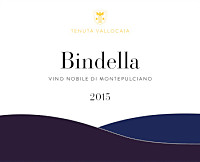
|
|
Vino Nobile di Montepulciano 2015 |
|
| Bindella (Tuscany, Italy) | |
 Sangiovese (85%), Colorino del Valdarno, Canaiolo Nero, Mammolo (15%) Sangiovese (85%), Colorino del Valdarno, Canaiolo Nero, Mammolo (15%) | |
| Price: € 18.00 | Score: |
 Brilliant ruby red and nuances of ruby red, moderate transparency. Brilliant ruby red and nuances of ruby red, moderate transparency. Intense, clean, pleasing and refined, starts with hints of black
cherry, plum and violet followed by aromas of blueberry, raspberry, rose,
chocolate, tobacco, vanilla and menthol. Intense, clean, pleasing and refined, starts with hints of black
cherry, plum and violet followed by aromas of blueberry, raspberry, rose,
chocolate, tobacco, vanilla and menthol.
 Tannic attack and however balanced by alcohol, good body, intense
flavors, pleasing crispness. Tannic attack and however balanced by alcohol, good body, intense
flavors, pleasing crispness.
 Persistent finish with flavors of black cherry, plum and raspberry. Persistent finish with flavors of black cherry, plum and raspberry. 22 months in cask, 6 months in bottle. 22 months in cask, 6 months in bottle. |
|
 Game, Roasted meat, Stewed and braised meat, Hard cheese Game, Roasted meat, Stewed and braised meat, Hard cheese |
|

|
|
Vino Nobile di Montepulciano I Quadri 2015 |
|
| Bindella (Tuscany, Italy) | |
 Sangiovese Sangiovese | |
| Price: € 27.00 | Score: |
 Brilliant ruby red and nuances of ruby red, moderate transparency. Brilliant ruby red and nuances of ruby red, moderate transparency. Intense, clean, pleasing, refined and elegant, starts with hints of
black cherry, plum and raspberry followed by aromas of violet, geranium,
blackberry, peony, chocolate, tobacco, cinnamon, pink pepper, mace, vanilla
and menthol. Intense, clean, pleasing, refined and elegant, starts with hints of
black cherry, plum and raspberry followed by aromas of violet, geranium,
blackberry, peony, chocolate, tobacco, cinnamon, pink pepper, mace, vanilla
and menthol.
 Tannic attack and however balanced by alcohol, full body, intense
flavors, pleasing crispness. Tannic attack and however balanced by alcohol, full body, intense
flavors, pleasing crispness.
 Very persistent finish with long flavors of black cherry, plum and
raspberry. Very persistent finish with long flavors of black cherry, plum and
raspberry.
 20 months in cask, 12 months in bottle. 20 months in cask, 12 months in bottle. |
|
 Game, Roasted meat, Stewed and braised meat, Hard cheese Game, Roasted meat, Stewed and braised meat, Hard cheese |
|

|
|
Mufìt 2016 |
|
| Fattoria Ca' Rossa (Emilia Romagna, Italy) | |
 Malvasia Bianca Malvasia Bianca | |
| Price: € 12.00 | Score: |
 Brilliant golden yellow and nuances of straw yellow, transparent. Brilliant golden yellow and nuances of straw yellow, transparent. Intense, clean, pleasing and refined, starts with hints of grape,
apricot and broom followed by aromas of banana, peach, white rose,
grapefruit, apple, pear and sage. Intense, clean, pleasing and refined, starts with hints of grape,
apricot and broom followed by aromas of banana, peach, white rose,
grapefruit, apple, pear and sage.
 Crisp attack and however balanced by alcohol, good body, intense
flavors, pleasing roundness. Crisp attack and however balanced by alcohol, good body, intense
flavors, pleasing roundness.
 Persistent finish with flavors of grape, apricot and pear. Persistent finish with flavors of grape, apricot and pear. Produced with grapes affected by botrytis cinerea (noble rot). Aged in
steel tanks. Produced with grapes affected by botrytis cinerea (noble rot). Aged in
steel tanks.
|
|
 Broiled crustaceans, Pasta and risotto with fish, Mushroom soups Broiled crustaceans, Pasta and risotto with fish, Mushroom soups |
|
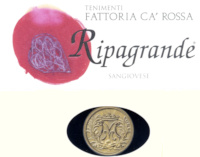
|
|
Ripagrande 2015 |
|
| Fattoria Ca' Rossa (Emilia Romagna, Italy) | |
 Sangiovese Sangiovese | |
| Price: € 16.00 | Score: |
 Intense ruby red and nuances of ruby red, little transparency. Intense ruby red and nuances of ruby red, little transparency. Intense, clean, pleasing and refined, starts with hints of black
cherry, plum and blackberry followed by aromas of dried violet, raspberry,
blueberry, tamarind, chocolate, tobacco and vanilla. Intense, clean, pleasing and refined, starts with hints of black
cherry, plum and blackberry followed by aromas of dried violet, raspberry,
blueberry, tamarind, chocolate, tobacco and vanilla.
 Tannic attack and however balanced by alcohol, good body, intense
flavors, pleasing roundness. Tannic attack and however balanced by alcohol, good body, intense
flavors, pleasing roundness.
 Persistent finish with flavors of black cherry, plum and blackberry. Persistent finish with flavors of black cherry, plum and blackberry. 14 months in barrique, 12 months in bottle. 14 months in barrique, 12 months in bottle. |
|
 Stuffed pasta with meat, Roasted meat, Broiled meat and barbecue, Stewed meat with mushrooms Stuffed pasta with meat, Roasted meat, Broiled meat and barbecue, Stewed meat with mushrooms |
|
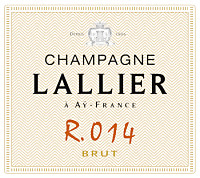
|
|
Champagne Brut R.014 |
|
| Lallier (Champagne, France) | |
 Pinot Nero (56%), Chardonnay (44%) Pinot Nero (56%), Chardonnay (44%) | |
| Price: € 39.00 | Score: |
 Brilliant golden yellow and nuances of golden yellow, fine and
persistent perlage, very transparent. Brilliant golden yellow and nuances of golden yellow, fine and
persistent perlage, very transparent.
 Intense, clean, pleasing, refined and elegant, starts with hints of
apple, bread crust and honey followed by aromas of banana, grapefruit,
butter, marzipan, honeysuckle, plum, tangerine, croissant and hazelnut. Intense, clean, pleasing, refined and elegant, starts with hints of
apple, bread crust and honey followed by aromas of banana, grapefruit,
butter, marzipan, honeysuckle, plum, tangerine, croissant and hazelnut.
 Effervescent and crisp attack, however balanced by alcohol, good body,
intense flavors, pleasing roundness. Effervescent and crisp attack, however balanced by alcohol, good body,
intense flavors, pleasing roundness.
 Persistent finish with flavors of apple, grapefruit and honey. Persistent finish with flavors of apple, grapefruit and honey. Refermented in bottle and aged on its lees for some years. Refermented in bottle and aged on its lees for some years. |
|
 Pasta and risotto with crustaceans, Stewed fish, Roasted white meat, Roasted fish Pasta and risotto with crustaceans, Stewed fish, Roasted white meat, Roasted fish |
|
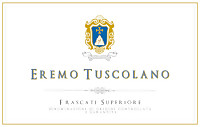
|
|
Frascati Superiore Eremo Tuscolano 2017 |
|
| Valle Vermiglia (Latium, Italy) | |
 Malvasia del Lazio (60%), Malvasia di Candia (10%), Trebbiano Toscano (10%), Trebbiano Giallo (10%), Bombino Bianco (10%) Malvasia del Lazio (60%), Malvasia di Candia (10%), Trebbiano Toscano (10%), Trebbiano Giallo (10%), Bombino Bianco (10%) | |
| Price: € 18.00 | Score: |
 Brilliant straw yellow and nuances of greenish yellow, very
transparent. Brilliant straw yellow and nuances of greenish yellow, very
transparent.
 Intense, clean, pleasing, refined and elegant, starts with hints of
apple, pear and peach followed by aromas of hawthorn, citrus fruits, peach,
pineapple, jasmine, broom, almond, thyme and mineral. Intense, clean, pleasing, refined and elegant, starts with hints of
apple, pear and peach followed by aromas of hawthorn, citrus fruits, peach,
pineapple, jasmine, broom, almond, thyme and mineral.
 Crisp attack and however balanced by alcohol, good body, intense
flavors, agreeable. Crisp attack and however balanced by alcohol, good body, intense
flavors, agreeable.
 Persistent finish with flavors of apple, peach and pineapple. Persistent finish with flavors of apple, peach and pineapple. 8 months in steel tanks. 8 months in steel tanks. |
|
 Fried fish, Pasta with fish, Risotto with crustaceans, Sauteed crustaceans, Sauteed white meat, Dairy products Fried fish, Pasta with fish, Risotto with crustaceans, Sauteed crustaceans, Sauteed white meat, Dairy products |
|
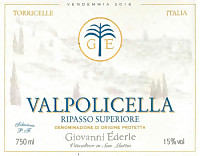
|
|
Valpolicella Ripasso Superiore 2016 |
|
| Giovanni Ederle (Veneto, Italy) | |
 Corvina (50%), Corvinone (30%), Rondinella (20%) Corvina (50%), Corvinone (30%), Rondinella (20%) | |
| Price: € 28.50 | Score: |
 Brilliant ruby red and nuances of garnet red, moderate transparency. Brilliant ruby red and nuances of garnet red, moderate transparency. Intense, clean, pleasing and refined, starts with hints of blackberry,
plum and black cherry followed by aromas of violet, raspberry, blueberry,
chocolate, tobacco, mace, vanilla and menthol. Intense, clean, pleasing and refined, starts with hints of blackberry,
plum and black cherry followed by aromas of violet, raspberry, blueberry,
chocolate, tobacco, mace, vanilla and menthol.
 Properly tannic attack and however balanced by alcohol, good body,
intense flavors, pleasing roundness. Properly tannic attack and however balanced by alcohol, good body,
intense flavors, pleasing roundness.
 Persistent finish with flavors of blackberry, plum and black cherry. Persistent finish with flavors of blackberry, plum and black cherry. 12 months in cask. 12 months in cask. |
|
 Broiled meat and barbecue, Roasted meat, Stewed meat with mushrooms, Hard cheese Broiled meat and barbecue, Roasted meat, Stewed meat with mushrooms, Hard cheese |
|

|
|
Amarone della Valpolicella 2013 |
|
| Giovanni Ederle (Veneto, Italy) | |
 Corvina (50%), Corvinone (25%), Rondinella (20%), Croatina (5%) Corvina (50%), Corvinone (25%), Rondinella (20%), Croatina (5%) | |
| Price: € 40.00 | Score: |
 Brilliant ruby red and nuances of garnet red, little transparency. Brilliant ruby red and nuances of garnet red, little transparency. Intense, clean, pleasing and refined, starts with hints of plum,
blackberry and black cherry followed by aromas of dried violet, blueberry,
chocolate, tobacco, leather, rosemary, vanilla and menthol. Intense, clean, pleasing and refined, starts with hints of plum,
blackberry and black cherry followed by aromas of dried violet, blueberry,
chocolate, tobacco, leather, rosemary, vanilla and menthol.
 Tannic attack and however balanced by alcohol, full body, intense
flavors, pleasing roundness. Tannic attack and however balanced by alcohol, full body, intense
flavors, pleasing roundness.
 Persistent finish with flavors of plum, blackberry and black cherry. Persistent finish with flavors of plum, blackberry and black cherry. 18 months in cask, 18 months in bottle. 18 months in cask, 18 months in bottle. |
|
 Game, Roasted meat, Stewed and braised meat, Hard cheese Game, Roasted meat, Stewed and braised meat, Hard cheese |
|
News |
|
In this section are published news and information about events concerning the world of wine and food. Whoever is interested in publishing this kind of information can send us a mail to our address.
|
AquavitaeReview of Grappa, Distillates and Brandy |
|
|
||||||||||||
Wine Guide ParadeSeptember 2018
|
| |||||||
Privacy Policy | |||||||


| Copyright © 2002-2024 Antonello Biancalana, DiWineTaste - All rights reserved |
| All rights reserved under international copyright conventions. No part of this publication and of this WEB site may be
reproduced or utilized in any form or by any means, electronic or mechanical, without permission in writing from DiWineTaste. |